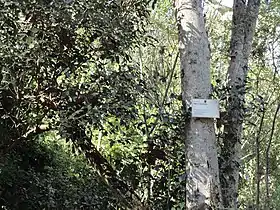| Forest olive | |
|---|---|
 | |
| In the KwaZulu-Natal Botanical Garden | |
| Scientific classification | |
| Kingdom: | Plantae |
| Clade: | Tracheophytes |
| Clade: | Angiosperms |
| Clade: | Eudicots |
| Clade: | Asterids |
| Order: | Lamiales |
| Family: | Oleaceae |
| Genus: | Olea |
| Species: | O. woodiana |
| Binomial name | |
| Olea woodiana | |
Olea woodiana, known commonly as the forest olive or black ironwood (Afrikaans: Bosolienhout), is an African tree species belonging to the olive family (Oleaceae).[1]
The tree grows in lower-elevation hill forests from Kenya, Tanzania, Eswatini, and South Africa.[2][3]
Description
Olea woodiana is a medium-sized to tall tree.[4] The axillary or terminal inflorescences carry small white flowers that are fragrant.[5]
Fruit are produced from late summer.[4] They are oval-shaped and ripen to a purple black colour, when they are consumed by birds.[4]
Subspecies
There are two recognized subspecies:[3]
- Olea woodiana subsp. disjuncta – Kenya, Tanzania
- Olea woodiana subsp. woodiana – Eswatini, South Africa
References
Wikimedia Commons has media related to Olea woodiana.
- ↑ "Botanische Jahrbücher für Systematik, Pflanzengeschichte und Pflanzengeographie". v.17 (1893). 1893.
{{cite journal}}: Cite journal requires|journal=(help) - ↑ "Olea woodiana". Germplasm Resources Information Network. Agricultural Research Service, United States Department of Agriculture. Retrieved 26 December 2012.
- 1 2 Kew World Checklist of Selected Plant Families Olea woodiana
- 1 2 3 "Olea woodiana". Witbos inheemse kwekery. Archived from the original on 9 December 2016. Retrieved 26 December 2012.
- ↑ Encyclopedia of Life treatment: ''Olea woodiana . accessed 2.2.2013
This article is issued from Wikipedia. The text is licensed under Creative Commons - Attribution - Sharealike. Additional terms may apply for the media files.